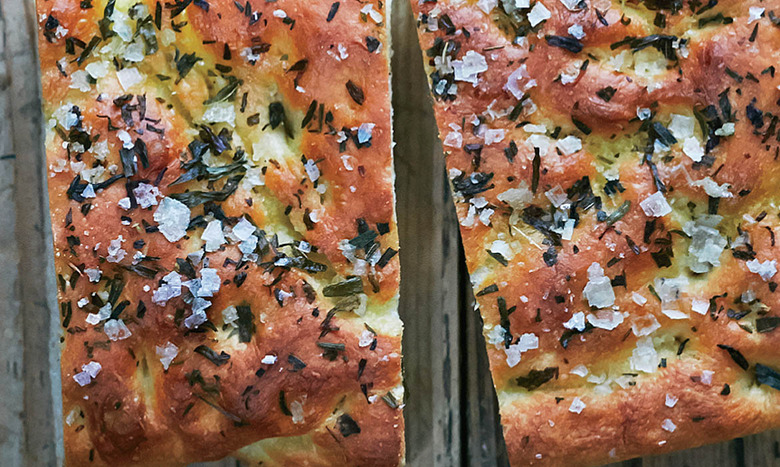A Versatile Focaccia Recipe
A Versatile Focaccia Recipe
Focaccia can be the canvas for any variety of toppings, flavors, and textures. My favorites are the ingredients that are simple enough to enhance the flavor of the bread, like a good olive oil and a handful of fresh herbs tossed with a little crunchy coarse salt. For this recipe, you will need an 18-by-13-inch rimmed baking sheet, also called a half sheet pan, or one in a similar size. The dough can also be shaped into rolls, breadsticks, or into pizza rounds.Excerpted from One Dough, Ten Breads, © 2016 by Sarah Black. Reproduced by permission of Houghton Mifflin Harcourt. All rights reserved.
Servings
15

Ingredients
- 1 1/2 teaspoon active dry yeast
- 2 teaspoon table salt
- 1 3/4 ounce warm water
- 16 ounce unbleached bread flour
- 11 1/2 ounce cool water
- vegetable oil, as needed
- 2 tablespoon olive oil, plus more for the baking sheet
- 2 tablespoon dried tarragon
- 1 tablespoon coarse salt
Directions
- Measure the yeast and the table salt separately and set them aside. Weigh the warm water into a small bowl. It should feel hot to the touch, between 105 degrees and 115 degrees F. Sprinkle the yeast on top of the water, stir to dissolve, and set aside.
- Weigh the flour into a large mixing bowl. Sprinkle the table salt on top of the flour, stir to incorporate, and then make a well in the center.
- Weigh the cool water into a small bowl. The cool water temperature should be between 70 degrees and 75 degrees F. Refer to page 17 to calculate the exact temperature and measure it with a thermometer, or gauge the approximate temperature by touch.
- Add the yeast mixture to the flour, stir 3 or 4 turns, then, little by little, add the cool water. Mix with your hands for 2 to 3 minutes, until all of the ingredients are incorporated, the grit of the salt is dissolved, and the dough forms a rough and shaggy mass, and then stop.
- Cover the bowl with a kitchen towel or plastic wrap and let the dough stand still for about 30 minutes.
- Sprinkle your work surface with flour and then use a plastic bowl scraper to scrape the dough out onto it. Tap your hands in a little flour, and then gently flatten the dough into a rectangle, with the short side facing you.
- Use your fingers or the plastic scraper to flip the top edge of the dough down to just below the center, then flip the bottom edge up to just above the center. Repeat this process for the right and left sides, then turn the dough over and dust off the flour.
- Oil a second large bowl with vegetable oil, then place the dough in it, seam side up, to oil the top. Then turn it seam side down, and cover the bowl with oiled plastic wrap. Mark the time with a felt-tipped pen on the plastic wrap and allow the dough to rest and rise in a moderately cool place until it has doubled in volume, 1 to 2 hours, depending on the heat of your environment.
- Once the dough has doubled in volume, oil an 18-by-13-inch rimmed baking sheet with olive oil and scrape the dough onto it, letting the dough relax into its own shape.
- Drizzle 2 tablespoons olive oil over the top of the dough, and then use your fingertips to gently press and dimple the dough, distributing the oil and stretching and pushing the dough evenly into the corners of the baking sheet.
- Because your dough is topped with olive oil, it does not need to be covered. Let it proof on the baking sheet until doubled in volume, 30 to 45 minutes.
- While the dough is proofing, preheat the oven to 450 degrees F, with a rack in the middle for baking and an empty pan for creating steam on the bottom of the oven. Have ready a spritzer filled with water near the oven, and approximately 8 ounces of hot water to pour into the empty pan.
- Once the shaped dough has approximately doubled in volume, again use your fingertips to make dimples all over the dough. Sprinkle the tarragon and then the coarse salt across the top and press the ingredients gently into the dough.
- Slide the baking sheet into the oven, and pour the hot water into the empty pan below to create steam before quickly closing the oven door.
- The focaccia should bake to a golden brown in 35 to 45 minutes, with bubbles and blisters and shimmering pools of oil.
- Let the focaccia cool for 10 minutes in the baking sheet, then remove it from the pan and let it cool completely on a wire rack.
- The differences between this bread and the baguette will be obvious: Because of the extra water in the dough and the gentler methods of dough manipulation, the crumb of the focaccia will be more open, airy, elastic, and tender, and will also be redolent of olive oil and tarragon, with the crunch of salt crystals.